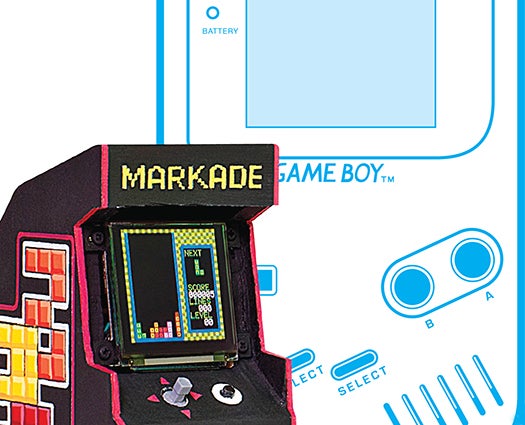The World’s Smallest Arcade
Three games shrunk, digitized, and boozed up to a whole new level

We may earn revenue from the products available on this page and participate in affiliate programs. Learn more ›
Mini Arcade Machine
In 2006, Mark Slevinsky fixed a Tron arcade game that a friend had left for trash. The work inspired similar gaming projects, ultimately leading him to a nerdy world record this year.
While surfing the Web, Slevinsky saw printed-paper models of arcade machines, each about the size of a Game Boy. Since he had already created an operating system for small microcontroller computers, he wondered: Why not build a functional mini arcade? He started by adapting the software to play classics such as Tetris, Space Invaders, and Breakout. Next, he needed power. Two 1.5-volt AAA batteries could support 13 hours of game play yet lacked the juice to run a tiny, five-volt LED screen. Retail power supply circuits couldn’t handle the voltage conversion—they all blew up—so he eventually made his own.
Slevinsky tucked the components into a wooden case and outfitted it with a joystick and button. He named it the Markade, and Guinness World Records deemed it the smallest device of its kind this year. Slevinsky’s friends typically play five minutes, which he says lasts “a round of each game, or until they develop hand cramps”—on par with old-school arcade consoles.
Time: 6 months
Cost: $90
BattleShots

Booze-infused Board Game
Bored by beer pong, Kevin Kittle turned Battleship into a booze-infused board game. He built Battleshots’ playing surface out of wood, steel, and acrylic and applied a grid using fluorescent paint that glows under a blacklight. Then Kittle drilled holes in wooden ships to hold neon shot glasses. As in the real game, a player tries to guess the locations of his opponent’s ships. If someone’s vessel takes a hit, he must do a shot. Kittle suggests using tonic-infused concoctions, because quinine glows in ultraviolet light. Sink responsibly.
Time: 2 months
Cost: $175
Tweeting Foosball Table

Digital Foosball Table
To build office camaraderie at SinnerSchrader, a Hamburg-based technology company, a team of developers designed a Foosball table that sends scores and standings to the Web in real time. Players log in to a mobile application with their Twitter handles. Photo sensors in the table’s chutes register goals and relay the data to a Wi-Fi–enabled Arduino microcontroller. The device updates players’ Twitter accounts while pushing game stats to their phones. At first, the company worried that publicizing games would discourage play, but two of the project’s developers—Thomas Jacob and Uli Schumacher—say it has created more foosball fanatics than ever before.
Time: 3 months
Cost: $150